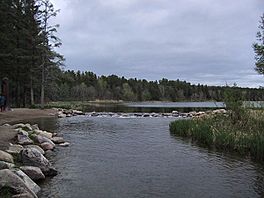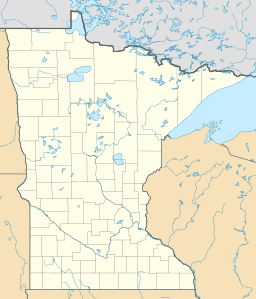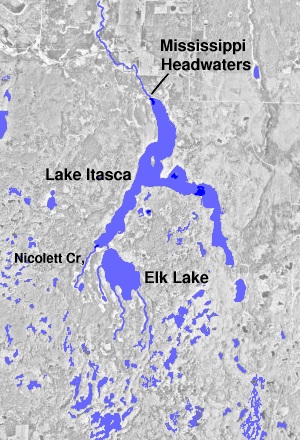Lake Itasca facts for kids
Quick facts for kids Lake Itasca |
|
|---|---|

The primary source of the Mississippi River on the edge of Lake Itasca
|
|
| Location | Itasca State Park, Clearwater County, Minnesota, US |
| Coordinates | 47°13′05″N 95°12′26″W / 47.21806°N 95.20722°W |
| Type | Glacial |
| Native name | Omashkoozo-zaaga'igan Error {{native name checker}}: parameter value is malformed (help) |
| Primary inflows | Nicolet Creek, Elk Lake outlet stream |
| Primary outflows | Mississippi River |
| Basin countries | United States |
| Surface area | 1.8 sq mi (4.7 km2) |
| Average depth | 20–35 ft (6–11 m) |
| Surface elevation | 1,475 ft (450 m) |
| Islands | Schoolcraft Island |
Lake Itasca is a small glacial lake in Minnesota, USA. It's famous because it's where the mighty Mississippi River begins! The lake is inside Itasca State Park. It covers about 1.8 square miles. The water is usually 20 to 35 feet deep. The lake sits 1,475 feet above sea level.
The Ojibwe people, who lived there first, called it Omashkoozo-zaaga'igan. This means "Elk Lake." Later, a man named Henry Schoolcraft changed the name to "Itasca." He made up the name from Latin words that mean "true head" of the Mississippi.
Contents
Where the Mississippi River Begins
Lake Itasca is the main source of the Mississippi River. This huge river flows 2,340 miles (3,770 km) all the way to the Gulf of Mexico.
There are smaller streams that flow into Lake Itasca. Some people think these tiny streams are the true start of the river. This is like how the Nile River and Amazon River sources are found.
In 1832, Henry Schoolcraft said Lake Itasca was the main source. Before that, in 1820, an expedition led by Lewis Cass thought Cass Lake was the source. Cass Lake is downstream from Itasca. Some people also believe that a fur trader named William Morrison found the lake first in 1804. He also said it was the Mississippi's source.
Streams Feeding the Lake
The western part of Lake Itasca gets water from two streams. Nicolet Creek starts from a nearby spring. Another small stream flows from Elk Lake into Itasca. Elk Lake itself gets water from two other streams. The Ojibwa people called Elk Lake Bekegamaag-zaaga'igan, meaning "Sidelake Lake."
In 1887, a man named Williard Glazier tried to say Elk Lake was the real source. He even called it Glazier Lake. The longest stream feeding Elk Lake comes from Little Elk Lake. This lake is 100 feet higher and 11 km upstream from Lake Itasca.
Protecting the Lake
Jacob V. Brower was a land surveyor and president of the Minnesota Historical Society. He spent five months exploring the lakes. He believed the streams south of Lake Itasca were too small to be the true source. However, modern explorers use tiny trickles to find the sources of rivers like the Amazon and Nile.
Brower worked hard to protect Lake Itasca from logging. On April 21, 1891, the Minnesota Legislature made it a state park. This happened by just one vote! Brower is now known as the "Father of Lake Itasca." The park's visitor center is named after him.
In the 1930s, the Civilian Conservation Corps changed the river's channel as it leaves the lake. They used bulldozers to make it look nicer for visitors. They drained the swamp nearby and dug a new channel. They also added man-made rock rapids.
A Place for Science
Lake Itasca is home to the University of Minnesota's Itasca Biological Station and Laboratories. Students and scientists come here to take classes and do research all year. The campus started in 1909. Some buildings are from the 1930s and 40s, while others are newer.
The Lake Itasca area is special because it's where the Mississippi River begins. It also has 25% of Minnesota's old growth forest. Plus, it's where three big North American habitats meet: the Great Plains, the Deciduous Forest, and the Coniferous Forest. You can see parts of all three in the park.
The unique nature of the Lake Itasca region has even inspired music. Composer Ferde Grofé wrote about the birthplace of the Mississippi River in his famous piece, the Mississippi Suite.
See also
 In Spanish: Lago Itasca para niños
In Spanish: Lago Itasca para niños





